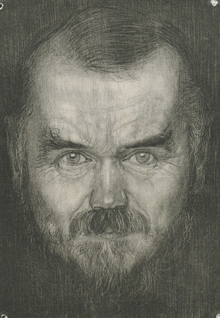Frederik van Eeden > Frederik van Eeden: the author
In his years as a medical student in Amsterdam, Frederik van Eeden manifested himself as a man of letters. He was chairman of the literary society Flanor and one of the founders of De Nieuwe Gids (The new guide), the Eighties Movement's magazine. The first issue of this magazine appeared in 1885 and its opening pages featured a contribution by Frederik van Eeden: a passage from De kleine Johannes (The little Johannes). Two years later, this philosophic fairy tale in prose was published in book form. It greatly influenced the younger generation of the time and has been translated into many languages, most recently into Urdu.
Prose
Frederik van Eeden's later prose works, such as Johannes Viator (1892) and the two sequels to De kleine Johannes (1905 and 1906), display the same contemplative bias as De kleine Johannes. His psychological novel Van de koele meren des doods (On the cool lakes of death), that appeared in 1900, was just as popular and was turned into a film by Nouchka van Brakel in 1982. Other novels by Van Eeden are De nachtbruid (The bride of dreams), published in 1909, and Sirius en Siderius I and II, that appeared in 1912 and 1914.
Poetry
The Eighties Movement focused principally on poetry. In the movement's view, a genuine poet was a prophet able to approximate the ultimate beauty and the divine through the bias of a language impregnated with poetry. Van Eeden made his debut as a poet in 1891, when the volume of verse Ellen, een lied van de smart (Ellen, a song of grief) appeared. Later on, three more volumes followed: Het lied van schijn en wezen (The song of semblance and essence) in 1895, Enkele verzen (A few verses) in 1898 and Van de passielooze lelie in 1901. A classic in this volume is De waterlelie (The Water-Lily).
Drama
Van Eeden's literary aspirations went beyond the ideal of beauty that was cherished by, for instance, the poet Willem Kloos, his friend and co-founder of De Nieuwe Gids. His works are of a philosophic and esoteric nature and often evidence social involvement. We see this in the play De broeders (The brothers), published in 1894, in which Van Eeden denounced dogmatic Christianity. This play was more suitable for reading than for playing, but Van Eeden also wrote plays that were actually staged, like Lioba in1897, IJsbrand in 1908 and De heks van Haarlem (The witch of Haarlem) in 1915.
Other works
Lioba, into which Van Eeden incorporated a love affair that came to an unhappy ending for him, mirrors his need for self-reflection in his writing. This need is also clearly evidenced in various non-literary works: his autobiography Happy humanity written in English (1912), the multi-volume excerpts from his diaries (1931-1934) and A study of dreams (1913), in which he analyzes his own dreams.
<< Back | Learn more about Frederik van Eeden: the idealist >>

